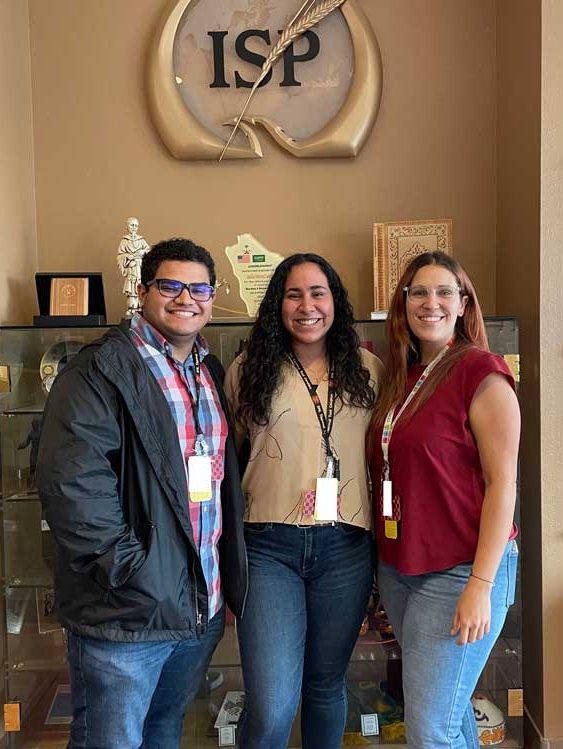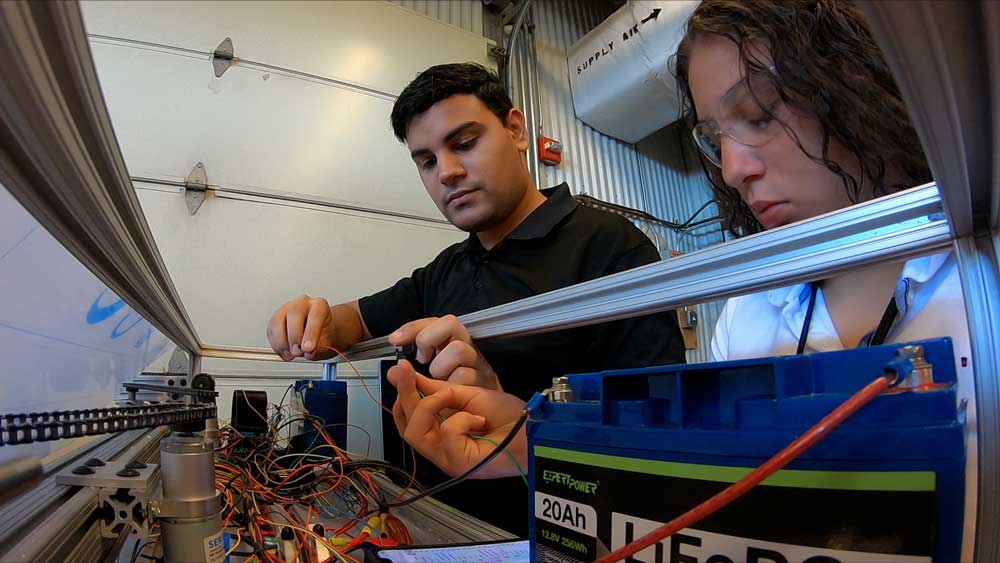Interns learn technical skills and gain insight into national labs

Sandia electrical engineer Rachid Darbali-Zamora is proof that the pipelines created by the NNSA Minority Serving Institution Partnership Program can help students make lasting impacts at the DOE national labs.
Rachid was one of the first Sandia interns in the Consortium for Integrating Energy Systems in Engineering and Science Education, a precursor to the present-day Consortium of Hybrid Resilient Energy Systems, or CHRES. He credits his internship experience and research over three summers at Sandia for shaping his dissertation topic in advanced power electronics and motivating him to graduate with his doctorate from the University of Puerto Rico, Mayagüez. Now a member of Sandia’s renewable energy and distributed systems integration group, he supports the CHRES program by mentoring future generations of student interns.
The opportunity to impact communities around the world was a major inspiration for Rachid’s university studies and decision to become a Sandian.
“Coming from Puerto Rico, I was attracted to all the research being performed to help modernize the electric grid back home,” Rachid said. “One of the greatest outcomes has been the ability to contribute to Sandia-led projects that focus on increasing energy resilience for communities in Puerto Rico. That was my ultimate goal in joining Sandia.”
A pipeline for top talent
CHRES is one of 24 consortium-based teams currently supported by the Minority Serving Institution Partnership Program to provide students underrepresented in science, technology, engineering and mathematics the opportunity to work at NNSA sites. Taken as a whole, the teams connect dozens of minority-serving colleges and universities from around the United States with NNSA labs and plants.
Led by Puerto Rico-based Ana G. Méndez University, CHRES offers summer internship and visiting faculty opportunities at Sandia, Lawrence Livermore National Laboratory and the National Energy Technology Laboratory. Other Hispanic-serving institutions in CHRES include the University of New Mexico, the University of Texas at El Paso and University of Puerto Rico, Mayagüez.
Sandia’s CHRES coordinator is Abraham Ellis, senior manager for renewable energy technologies. He was also involved with the previous program, which ended in 2020 prior to the forging of the current CHRES partnership. Both Sandia internship opportunities have focused on renewable and nuclear energy, microgrids, power electronics, energy storage and fire science. Such programs bridge research opportunities for students with diverse interests, backgrounds and goals.
“When they come to Sandia, CHRES interns work with top-notch researchers to investigate important science and technology questions using the Labs’ state-of-the-art tools and capabilities,” Abraham said. “They see what it’s like to work at a national laboratory and picture themselves in that role. We make sure that the internship experience furthers their education and motivates them to consider Sandia as a potential place to work when they graduate.”
He points out that CHRES is a great way to recruit top talent and enables stronger collaboration between Sandia and the Minority Serving Institution Partnership Program. The process takes time, but the benefits are significant and tangible.
“In 2017, during the first year of the CIESESE program, I hosted four students and one visiting faculty member from UPRM. For each of those students, the internship project turned into their thesis or dissertation, and one of them [Rachid] eventually became a Sandia employee. Witnessing that progression was very rewarding to see,” Abraham said.
Far-reaching impacts
Taking into account the former and current programs, Sandia has hosted nearly 70 summer interns and several visiting faculty members. These interactions have led to multiple joint research projects outside the Minority Serving Institution Partnership Program and dozens of joint conference and journal publications.
The benefits of the CHRES program are far-reaching, leaving a positive impact on students, Sandia and the students’ universities. The partnership with University of Puerto Rico, Mayagüez has been particularly strong and led to a cooperative research and development agreement in 2019 and a memorandum of understanding in 2020.
“This program is valuable because it provides excellent opportunities for CHRES students and faculty,” said Erick Aponte, the CHRES liaison for the University of Puerto Rico, Mayagüez. “It is also a win-win strategy for the laboratories because of the research and the potential for workforce development. The facilities that Sandia offers, combined with a state-of-the-art research culture, provide a unique opportunity for our students to complete part of their research work in a perfect research environment with the support of UPRM faculty and Sandia researchers.”
Internship successes
The environment at Sandia provides a safe space for interns to experiment, learn and gain unique insight in a team-focused research environment.
“I chose to participate in the CHRES program to explore new career interests and broaden my research skills,” said intern Namir Huertas, a doctoral student at Ana G. Méndez University. “I learned so much. My favorite part about Sandia is how passionate and dedicated everyone has been to ensure that interns have a fulfilling experience. My team made me feel welcomed and valued.”

Ansel Blumenthal, a current CHRES intern and University of New Mexico graduate student, agrees that the potential for workforce development and academic impact is substantial.
“The balance of responsibility and accountability when assisting on cutting-edge research projects, along with managers and coworkers who are willing to provide support and guidance when needed, has made for an ideal learning environment,” Ansel said.
Recruiting future generations
Big plans are in store for the future of the Labs’ CHRES program. In partnership with Ana G. Méndez University, Sandia has established a CHRES Undergraduate Research Capstone initiative to enable more undergraduate students to benefit from CHRES internships and be motivated to pursue graduate degrees in science, technology, engineering and math.
“We want to work with undergraduates throughout the fall and spring semesters, so they can gain more experience with research before applying for summer internships at Sandia. The initiative involves directed mentoring by university faculty and Sandia staff. We also expect these interactions to lead to broader partnership opportunities with university researchers and faculty,” Abraham said.
In addition to enhancing research opportunities for underrepresented undergraduate students, the CHRES program can help bring undergraduate and graduate students to Sandia.
“Programs such as CHRES can help us recruit talent for skill sets that are more difficult to find,” Abraham said.
The success of the Labs’ CHRES program is rooted in a commitment to supporting and inspiring each participant. Mentors, researchers and staff at Sandia are passionate about sharing their insight and experiences with the interns.
“As a student, I didn’t have a chance to work as an intern at a place like Sandia. My hope is that the CHRES program will help more minority students pursue successful careers in STEM,” Abraham said.